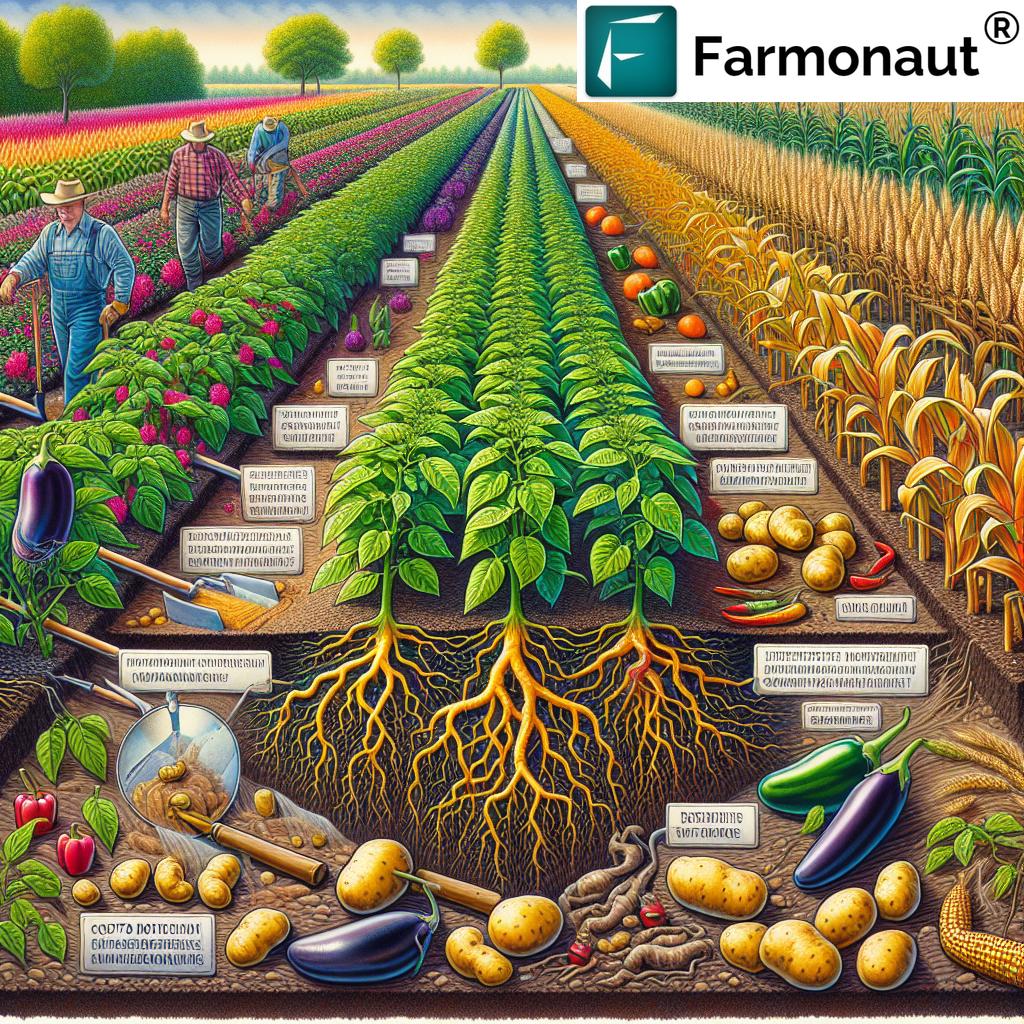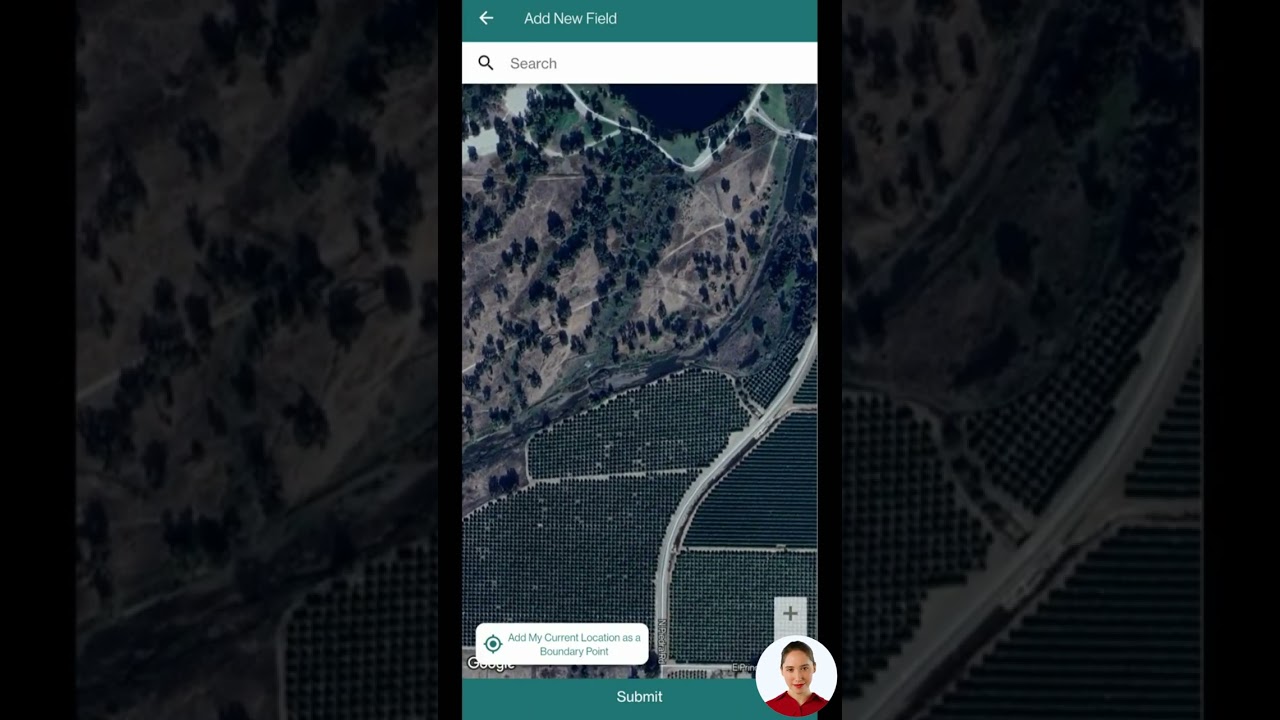Verticillium Wilt: 7 Powerful Ways to Manage Plant Disease
“Verticillium wilt can reduce crop yields by up to 50% in severely infected fields, impacting plant health significantly.”
- Introduction
- Understanding Verticillium Wilt: Biology & Disease Cycle
- Verticillium Wilt Symptoms: What to Look For
- Host Range: Which Plants Are Susceptible?
- Comparison Table: Management Strategies vs. Effectiveness
- Verticillium dahliae Management: 7 Powerful Ways
- How Farmonaut Supports Disease Management
- FAQ: Verticillium Wilt Management
- Conclusion
Introduction: Why Is Verticillium Wilt a Major Concern for Plant Health?
Verticillium wilt is a serious soil-borne fungal plant disease caused by species of the genus Verticillium, most notably Verticillium dahliae and Verticillium albo-atrum. This persistent threat affects a wide range of plants, including many of our essential and economically significant crops—such as tomatoes, potatoes, eggplants, peppers, strawberries, and various ornamental plants.
The pathogens infiltrate the plant’s vascular system, disrupting vital water and nutrient transport. This leads to wilting and chlorosis in plants, causing characteristic symptoms that may result in stunted growth, premature senescence, and in severe cases, plant death. Unfortunately, Verticillium species are highly resilient—capable of persisting in soil for years—even in the absence of a susceptible host.
Given the disease’s capacity to dramatically reduce crop yields and the difficulty in elimination due to Verticillium’s unique biology, growers must take an integrated approach to management. This guide covers:
- The biology and cycle of Verticillium fungi
- Common Verticillium wilt symptoms
- Host range & susceptible crops
- 7 powerful strategies to manage and reduce disease impact
- How advanced technology, including Farmonaut’s solutions, can help protect your plants and boost productivity
Let’s begin our in-depth journey into Verticillium wilt and learn effective methods to protect our plants and agricultural productivity!
Understanding Verticillium Wilt: Biology & Disease Cycle
What Causes Verticillium Wilt in Plants?
Verticillium wilt is caused by fungal pathogens of the genus Verticillium. The disease is primarily attributed to two species—Verticillium dahliae and Verticillium albo-atrum. These pathogens are notorious for their persistence and adaptability, making disease control especially challenging. (More on disease cycle at UC IPM).
Disease Cycle: How Does Verticillium Wilt Spread and Survive?
A key survival adaptation of Verticillium fungi is the production of microsclerotia—small, dark, highly resilient structures composed of compact fungal cells. These enable the pathogen to persist in soil for up to 10 years, even without a host plant.
Here’s the typical disease cycle:
- Microsclerotia survive in soil: They can exist for years, waiting for susceptible plants.
- Germination and root infection: When favorable conditions (moist soil, cool to moderate temperatures) and a host are present, microsclerotia germinate and infect roots.
- Vascular colonization: The fungus infiltrates the vascular system—the plant’s xylem—disrupting water and nutrient transport.
- Systemic movement: Verticillium spreads upward in the plant, causing wilting and chlorosis.
- Symptom development and spread: Plant parts may die, releasing more fungal material back into the soil.
Verticillium wilt thrives under mild, humid, or moist soil conditions, but the most severe symptoms often emerge during drier and hot periods when plant stress is high. This makes the disease both insidious and difficult to predict.
NOTE: Using remote sensing and multispectral imaging, precision tools like Farmonaut’s large-scale monitoring solution can help detect early signs of stress or wilting across entire fields—empowering farmers to take action before widespread losses occur.
Verticillium Wilt Symptoms: What to Look For
Identifying Infection: Key Visual Symptoms and Signs
The symptoms of Verticillium wilt are often first noticed when plants exhibit wilting and chlorosis—especially during periods of water stress or midday heat. However, certain features are particularly diagnostic:
- Wilting: Sudden or progressive wilting of leaves, often starting on just one side of the plant.
- Chlorosis: Yellowing of leaves, typically beginning at the margins and progressing inward.
- Premature senescence: Early aging or dieback of leaves, especially on lower parts of the plant.
- Necrosis: Brown or scorched-looking leaf edges or spots.
- Vascular discoloration: When stems are cut lengthwise, brown discoloration of vascular tissue is often observable—a hallmark of Verticillium infection.
- Generalized or one-sided symptoms: Entire plant may appear affected, or just one half (a distinguishing sign).
The severity and pattern of these symptoms are influenced by the plant’s susceptibility, environmental conditions, and the levels of pathogen inoculum in the soil.
“Over 400 plant species are susceptible to Verticillium wilt, making it a widespread threat to global agriculture.”
Host Range: Which Plants Are Susceptible?
One of the most concerning aspects of Verticillium wilt is its vast host range. Over 350 plant species have been documented as susceptible to infection by different Verticillium species (see Wikipedia Verticillium wilt page).
Some of the most at-risk crops include:
- Solanaceous vegetables—Tomatoes, Potatoes, Eggplants, Peppers
- Strawberries
- Cotton, Sunflower, Alfalfa
- Ornamental plants—including Maple, Smoke tree, Rose, and Chrysanthemum, among many others
In contrast, monocots such as grasses (including cereals: corn, wheat, barley, and rye) and gymnosperms generally present strong natural resistance.
Knowing which plants are susceptible is critical for effective management strategies and crop rotation planning.
Comparison Table: Management Strategies vs. Effectiveness
To ensure clarity and informed disease management, here’s an at-a-glance comparison of the 7 powerful strategies for Verticillium dahliae management.
*When used in combination with other methods for early detection and precise management decisions.
Verticillium dahliae Management: 7 Powerful Ways to Reduce Disease Impact
Combating Verticillium wilt effectively requires an integrated management strategy that combines multiple approaches. Let’s examine each of the seven most impactful ways you can reduce this soil-borne threat in your crops:
1. Resistant Plant Varieties for Verticillium: Your First Line of Defense
One of the most effective strategies for managing Verticillium wilt is the use of resistant plant varieties (UC IPM: Potato). Choosing cultivars bred for disease resistance can drastically reduce disease incidence, sometimes by up to 90%.
- Tomatoes: Seek varieties labeled with “V” for Verticillium resistance.
- Potatoes: Some cultivars (e.g., ‘Russet Norkotah’) are highly susceptible, while others show resistance or tolerance.
- Eggplants, Peppers: Newer cultivars may offer increased resistance.
Tip: Always verify the disease resistance status of seeds and starts before purchase. Resistant varieties not only help reduce Verticillium wilt symptoms but also contribute to long-term soil health, as fewer infected plants mean fewer pathogens returned to the soil.
Related resource: Farmonaut’s remote satellite-based platform can assist in mapping the performance of different varieties by tracking plant health over time.
2. Crop Rotation to Reduce Wilt: Starving the Pathogen
Long-term crop rotation to reduce wilt pressure is a fundamental practice for managing soil-borne plant disease. Because Verticillium can affect more than 400 species, rotations must be well-planned and preferably of extended duration.
- Optimal Rotations: Rotate susceptible crops with non-hosts such as corn, wheat, or barley for at least 4–6 years.
- Partial Effects: Crop rotation alone may not eliminate Verticillium due to persistent microsclerotia. But, it can significantly reduce levels in soil when used with other management tactics.
Careful planning, supported by ongoing monitoring, leads to more predictable results and healthier soils. Modern decision-support tools like the Farmonaut API can visually track crop sequences and highlight at-risk fields.
3. Sanitation Practices: Preventing Pathogen Spread
Proper sanitation practices are essential for Verticillium dahliae management:
- Remove and destroy infected plant debris after harvest—do not compost diseased material as microsclerotia can survive normal composting processes.
- Clean all equipment and shoes before moving to another field, especially after working with infected plants.
- Avoid moving soil between fields inadvertently, as fungal pathogens can hitchhike on tires, tools, and machinery.
- Control weeds and non-crop hosts that are susceptible to Verticillium and contribute to recurring infections.
These straightforward measures can reduce inoculum levels in the soil and prevent introduction to new areas. Pairing this with blockchain-enabled traceability solutions from Farmonaut can ensure transparency and help manage field histories efficiently.
4. Irrigation Management: Lessening Disease Severity
Although Verticillium wilt is not directly spread by water, excessive soil moisture can favor germination of microsclerotia and entry of the pathogen into plant roots. Conversely, plant stress due to water shortage may exacerbate wilting and chlorosis symptoms in infected plants.
- Optimal practices: Employ precise, measured irrigation—neither overwatering nor allowing severe drought stress to occur.
- Improve field drainage and avoid standing water; raised beds may benefit highly susceptible crops.
- Drip irrigation can help reduce canopy humidity and lower the risk of other diseases that may compound Verticillium’s effects.
Satellite-derived soil moisture maps provided by Farmonaut’s platform help farmers make informed irrigation decisions, reducing both input costs and disease stress.
5. Soil Fumigation: Specialized, High-Impact Intervention
For highly valuable or acutely infested fields, soil fumigation using chemicals like chloropicrin may be considered. This approach can substantially lower soil inoculum, though it is not always a practical solution for all farmers.
- Overview: Soil fumigants reduce pathogen populations prior to planting susceptible crops.
- Must be professionally applied with appropriate safety protocols; regulations may restrict use in many areas.
- Fumigation is most cost-effective when used in conjunction with resistant varieties and good sanitation.
- Environmental impact and cost are factors for consideration.
Always follow local guidelines and consult with agricultural extension services before considering fumigation. For most growers, emphasis should remain on rotation, resistant varieties, and sanitation.
6. Weed & Volunteer Host Control: Reducing Hidden Pathogen Reservoirs
Certain weeds and volunteer plants serve as alternative hosts for Verticillium species, sustaining the disease cycle even when major crops are rotated out.
- Routinely scout and remove broadleaf weeds in and around fields, especially in non-crop years.
- Many ornamental plants and “volunteers” from previous susceptible crops can perpetuate the disease—eradicate these where possible.
- Integrated weed management can reduce the reservoir of pathogens.
Consider leveraging Farmonaut’s satellite monitoring to identify persistent weed patches for targeted intervention.
7. Satellite Monitoring & Technology Solutions: Early Detection and Precision Management
Advanced technology, such as satellite crop health monitoring, can now play a pivotal role in the integrated management of wilt diseases:
- Farmonaut’s satellite & AI platform offers multispectral monitoring and real-time crop health analytics. It helps farmers pinpoint stressed or symptomatic plants, optimize inputs, and assess effectiveness of rotations, sanitation, and irrigation protocols.
- AI-driven advisory tools can provide tailored recommendations to address Verticillium risk based on field-specific data.
- Remote sensing enables large-scale, cost-effective field scouting without time-intensive ground surveys.
With mobile and web app access, as well as API integration, Farmonaut puts precision agriculture and proactive disease management into every farmer’s hands.
How Farmonaut Supports Disease Management and Plant Health
At Farmonaut, our mission is to enable growers to reduce plant disease risks like Verticillium wilt through innovative, accessible technology. Here’s how our core solutions directly support disease management for crops and ornamental plants:
- Real-Time Crop Health Monitoring: Use satellite imagery and AI to detect early signs of stress, wilting, or irregular crop performance.
- Soil Moisture & Vascular Health Insights: Analyze spatial and temporal moisture variations to adjust irrigation, reducing disease favorability.
- AI-Based Advisory: Our Jeevn AI system provides actionable advice on rotation planning, sanitation, and cultivation, including reminders and risk warnings for Verticillium wilt.
- Blockchain Traceability: For those seeking the highest level of food safety and traceability, Farmonaut’s product traceability platform secures transparency from field to consumer.
- Fleet and Resource Optimization: Our fleet management tools can help large farming operations better deploy sanitation equipment or monitor multi-location disease risk.
- Environmental Sustainability: By optimizing management, Farmonaut helps lower unnecessary chemical use (e.g., fungicides, fumigants) and input waste—assisting with carbon footprinting and sustainability compliance.
Our solutions are available on Android, iOS, and web platforms, ensuring global, round-the-clock access for every user—from individual farmers to large agribusinesses and governmental agencies. Visit our admin platform for managing large-scale fields or leveraging our API for integration with third-party systems.
FAQ: Verticillium Wilt Management
- Q: Can Verticillium wilt affect all plants?
A: Verticillium wilt affects over 400 plant species, including key crops like tomatoes, potatoes, eggplants, peppers, strawberries, and many ornamentals. However, most grasses, cereals, and gymnosperms are resistant. - Q: How do I recognize Verticillium wilt symptoms early?
A: Early signs include localized wilting, leaf yellowing (chlorosis), premature leaf drop, and brown discoloration in vascular tissues, often on one side of the plant. - Q: Can I eliminate Verticillium fungi completely from my field?
A: Complete eradication is challenging due to the pathogen’s resilient microsclerotia. Long-term integrated management—including crop rotation, resistant varieties, sanitation, and monitoring—is the best approach. - Q: Is soil fumigation always necessary?
A: No. Soil fumigation is reserved for high-value or severely infested fields and should always be combined with other approaches. Regulatory, environmental, and cost factors often limit its use. - Q: How can technology like Farmonaut help manage wilt diseases?
A: Farmonaut provides satellite crop health monitoring, soil moisture tracking, AI advisory, and traceability solutions that allow for early detection and targeted interventions, reducing both labor and chemical input. - Q: Why are ornamentals sometimes harder to protect against Verticillium wilt?
A: Many ornamental species lack well-developed resistant varieties, making cultural controls, sanitation, and technology-based monitoring even more crucial. - Q: Can I use Farmonaut platforms for insurance or carbon footprinting needs?
A: Yes, Farmonaut partners with financial institutions and offers crop loan & insurance verification (learn more), as well as carbon footprint analytics (details here).
Conclusion: Towards Healthier Plants and Sustainable Yields
Verticillium wilt stands as a persistent and challenging plant disease, capable of dramatically affecting crop yields and growers’ livelihoods globally. Its soil-borne fungal pathogens—Verticillium dahliae and others—survive for many years in the ground and swiftly infect susceptible hosts, disrupting their vascular systems and causing wilting, chlorosis, and decline.
Overcoming this challenge requires comprehensive, science-based management strategies:
planting resistant cultivars, crop rotations, sanitation, irrigation management, weed control, and targeted chemical interventions when needed. Technology now empowers us to monitor, analyze, and respond to disease threats faster and more precisely than ever before. At Farmonaut, we are committed to providing affordable satellite, AI, and blockchain tools that empower all growers—small or large—to thrive in the face of disease and environmental challenges.
With the right knowledge, tools, and ongoing vigilance, we can keep Verticillium wilt in check—protecting the health of our plants, the bounty of our harvests, and the sustainability of our future.
Explore More Farmonaut Solutions
- Carbon Footprinting – Monitor and reduce your environmental impact for sustainable farming.
- Blockchain Product Traceability – Enhance trust and transparency in your supply chains.
- Crop Loan and Insurance Solutions – Secure satellite-based verification for financing and insurance needs.
- Large Scale Farm Management – Effortlessly oversee hundreds to thousands of hectares with advanced analytics.
- Fleet and Resource Management – Optimize the deployment and maintenance of your agricultural fleet.
- Farmonaut Weather & Satellite API – Integrate cutting-edge crop and weather data directly into your agri-business workflows (Developer Docs).
Ready to protect your crops with the most advanced, affordable tools in precision agriculture? Get started with Farmonaut now!




















